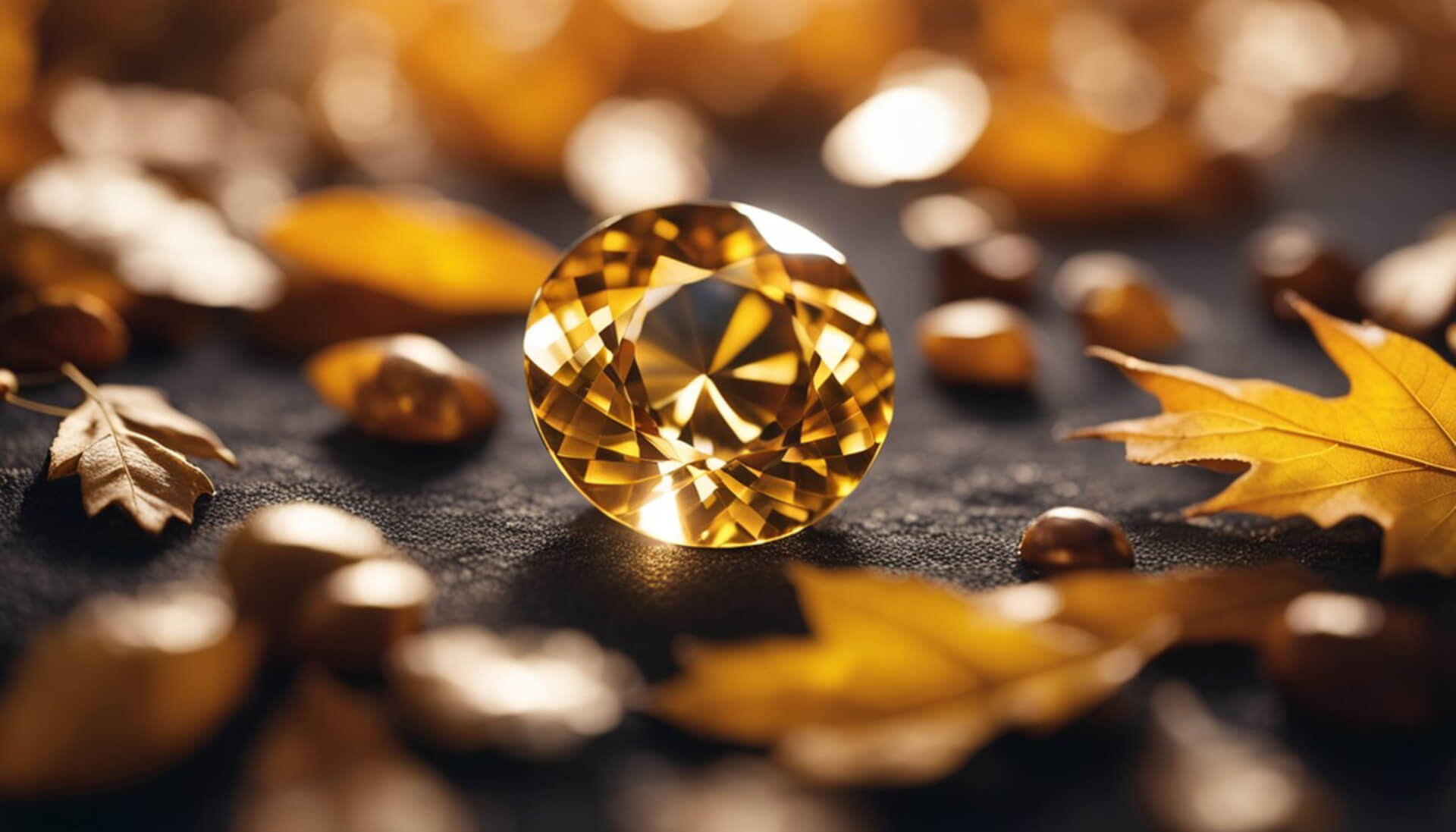The birthstones for November, topaz and citrine are prized for their captivating beauty and rich history.
Traditionally representing warmth and tranquility, these gemstones vary widely in color and clarity. They are commonly found in golden, yellow, and amber hues. The allure of November’s birthstones has been celebrated through the ages, with each stone holding its unique place in lore and legend.
Topaz is renowned for its wide-ranging color palette, which includes colors beyond the typical yellow, such as blue, pink, and red.
The transformation from rough stone to sparkling gemstone reveals Topaz’s versatile beauty and durability, making it a popular choice for jewelry.
Citrine is believed to embody life’s vibrant energy with its sunny appearance.
It is less commonly found in nature but shares similar durability, contributing to its popularity.
Historical Significance
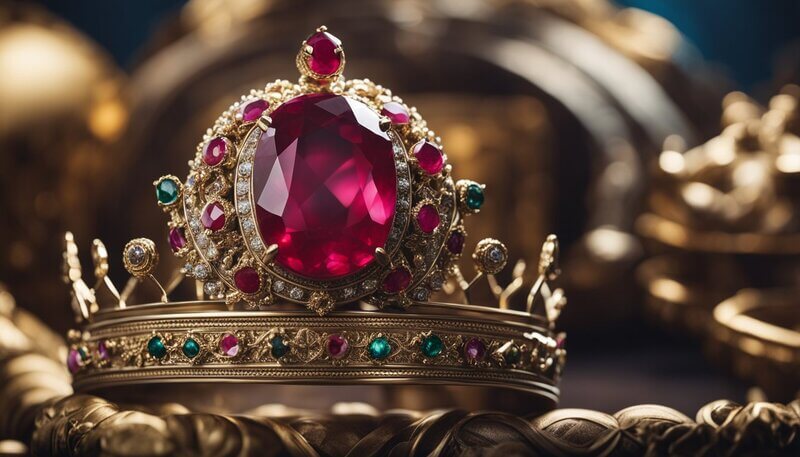
Ancient cultures imbued the November birthstones, citrine, and topaz, with meaning and utility. These gemstones were not only admired for their beauty but also ascribed significant power and used in a variety of rituals.
Ancient Traditions
Ancient Greeks and Romans regarded topaz as a powerful stone.
The Greeks believed it could increase strength and make its wearer invisible in times of emergency.
Romans associated topaz with Jupiter, their god of thunder and sky.
On the other hand, with its yellow hue, citrine was often mistaken for topaz, yet it held its own status.
Some thought it was to soothe tempers and calm the wearer.
Historical Uses
In Sanskrit texts, topaz was one of the stones called “pitaya,” which means beneficial to the body.
The Egyptians wore topaz amulets as talismans to protect against harm, and it was one of the stones found in King Tutankhamun’s tomb.
Citrine, known in Latin as ‘citrine’, which means “yellow,” was used in spells and talismans for its alleged ability to improve digestion and remove toxins from the body.
Embedded within their cultures, these gemstones transcended mere decoration, resonating with the vitality of the birth month they represented.
Types of November Birthstones
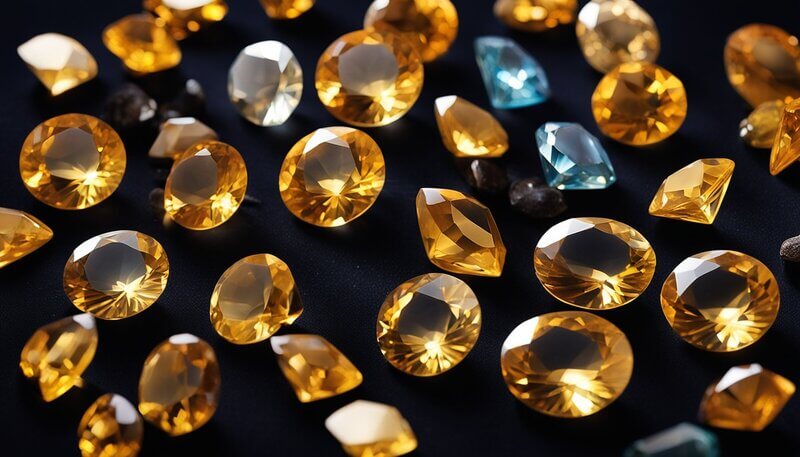
November is unique in that it offers two birthstones, topaz and citrine. These gems provide a range of colors and qualities for those born in this month. Both gems offer rich warmth in their tones, creating a sense of comfort and luxury for the wearer.
Topaz
Topaz is a silicate mineral found in an impressive spectrum of colors, from the golden hue of yellow topaz to the prized sherry-colored imperial topaz and even pink and colorless varieties.
Blue topaz, one of the most popular colors, is widely available due to an enhancement process that turns colorless topaz into blue.
Despite the availability of different colors, natural imperial topaz, with its vibrant orange-to-pink hues, is quite rare and sought after.
- Colors: Yellow, Orange, Blue, Pink, Colorless
- Notable Varieties: Imperial Topaz, Blue Topaz
Citrine
Citrine, a form of quartz, captivates with its transparent to translucent quality and derives its name from the lemon fruit due to its yellow to brownish-red colors.
Like Topaz, it also brings a calm energy and is treasured for its affordability and durability.
Unlike amethyst, its violet quartz counterpart, natural citrine is rare, often leading to heat-treated smoky quartz and amethyst being sold as citrine.
- Colors: Yellow to Brownish-Red
- Quartz Relation: Close to Amethyst, Rare
Physical and Chemical Properties
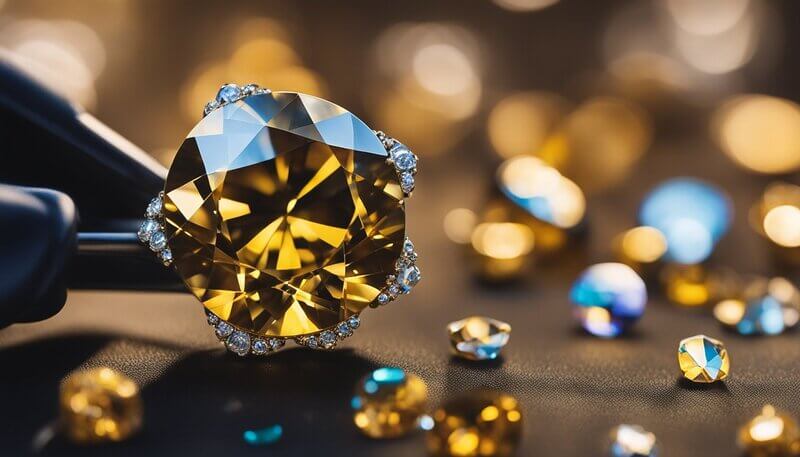
The physical and chemical characteristics of November’s Topaz and Citrine birthstones reveal a fascinating mineral composition and a spectrum of color variations. These stones possess distinct properties regarding cleavage and crystal structure, contributing to their unique aesthetics and durability.
Mineral Composition
Topaz is a silicate mineral of aluminum and fluorine with the chemical formula Al₂SiO₄(F, OH)₂.
It belongs to the silicate group of minerals, which comprises silicate units combined with various elements.
Citrine, on the other hand, is a variety of quartz primarily made of silicon dioxide (SiO₂).
- Topaz: Al₂SiO₄(F,OH)₂
- Citrine: SiO₂
Color Variations
The color of Topaz can range from colorless to a wide variety of hues, including blue, brown, orange, gray, yellow, green, pink, and reddish-pink.
It’s important to note that Topaz’s purest form is transparent and colorless, with impurities leading to various colorations.
Citrine’s colors range from pale yellow to brownish-orange and is known for its warm tones, which are caused by traces of iron in the quartz crystal.
- Topaz Colors: Colorless, Blue, Brown, Orange, Gray, Yellow, Green, Pink, Reddish-Pink
- Citrine Colors: Pale Yellow to Brownish-Orange
Cleavage and Crystal Structure
Topaz crystallizes in the orthorhombic system and has perfect cleavage in one direction, making it prone to split along parallel planes, which can be a challenge when cutting the gem.
Citrine belongs to the trigonal crystal system and does not have the cleavage that Topaz does, making it less susceptible to splitting during the cutting process.
Both Topaz and Citrine have a hardness of 8 on the Mohs scale, indicating quite a resilient nature.
Gemstone Quality and Grading
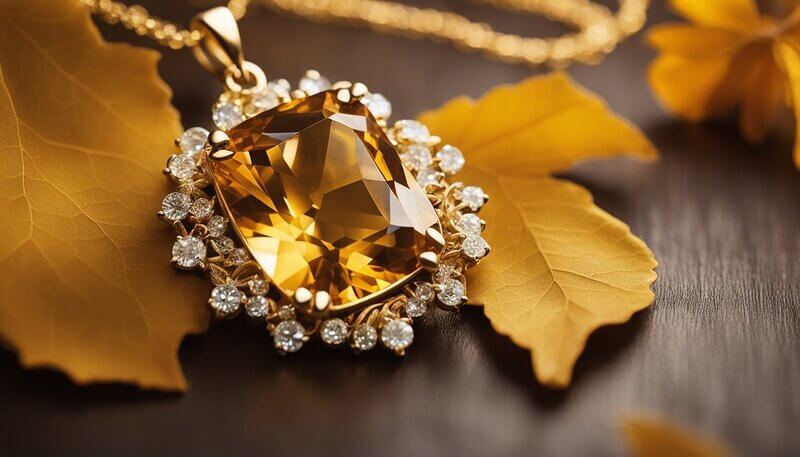
Evaluating the quality and grading of November birthstones involves carefully assessing their color and clarity, carat weight and size, and cut and shape.
Mastery in recognizing these characteristics can significantly affect their value and associated attributes, such as good fortune.
Color and Clarity
The allure of November’s topaz and citrine birthstones primarily comes from their color.
Topaz varies from a pale sky blue to deep Swiss blue, whereas citrine boasts shades from pale yellow to a rich, deep amber.
Another critical aspect of these gemstones is their clarity, with higher grades given to those that are free from inclusions to the naked eye. Stones with exceptional clarity and saturated color command higher prices.
- Topaz Color Spectrum: Sky Blue, Swiss Blue, London Blue
- Citrine Color Spectrum: Pale Yellow, Golden Yellow, Madeira
- Clarity: Eye Clean (No Visible Inclusions)
Carat Weight and Size
The carat weight of a gemstone measures its mass, with one carat equivalent to 0.2 grams.
November birthstones can range vastly in size, influencing the carat and ultimately, the gemstone’s value.
Larger topaz and citrine stones are available, but as the size increases, so does the importance of maintaining color consistency and clarity.
- Carat Weight: 1 carat = 0.2 grams
- Size: Available in a variety of sizes, with large specimens being particularly valuable if they maintain high-quality
Cut and Shape
The cut of November birthstones is where craftsmanship comes into play.
A skillful cut can enhance the gemstone’s natural color, maximize its luster, and even add to the perceived good fortune it brings.
Shapes are chosen to highlight the gemstone’s best attributes; whether it is a traditional round shape for consistency or a unique marquise to elongate the stone, the quality of the cut directly affects a gemstone’s brilliance and scintillation.
- Shapes: Round, Oval, Marquise, Cushion, Pear
- Cut Quality: Brilliant, Step, and Mixed Cuts are considered for maximizing luster and color display.
Healing and Metaphysical Properties
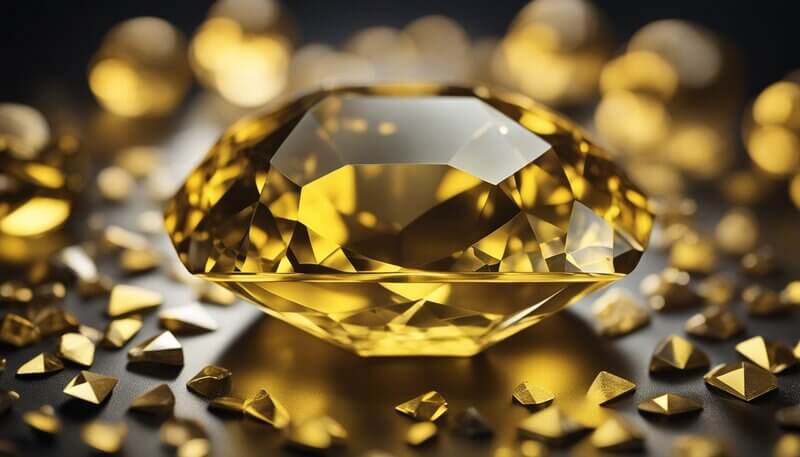
November birthstones are renowned for their diverse healing attributes and metaphysical properties, which can contribute to improved health and well-being. These gemstones are particularly valued for their potential to promote physical healing and emotional stability.
Physical Healing
Topaz and Citrine, the gemstones associated with November, are believed to possess notable healing properties.
Topaz is thought to be beneficial for promoting good health, specifically by aiding in alleviating sore joints. Its use in traditional practices includes believing it can stimulate the body’s healing processes.
Citrine, a quartz family gemstone, is also linked to physical wellness.
It is reputed for supporting vitality and good health, being associated with the body’s restoration and optimization of energy flow.
Emotional and Psychological Effects
Beyond their physical healing benefits, November’s birthstones are attributed to various emotional and mental advantages.
Topaz is often associated with promoting joy and abundance and enhancing intellect and wisdom.
It fosters love and happiness while strengthening the wearer’s emotional capacity.
Citrine is celebrated for attracting prosperity and success and holds a reputation for imbuing its wearer with confidence.
It is believed to carry positive energies, contributing to overall luck and protection in life.
Both gemstones, in their ways, are considered powerful for nurturing a sense of balance and strength within the emotional and psychological realms.
This can potentially lead to a more harmonious and fulfilled state of being.
November Birthstone Jewelry

November birthstone jewelry typically features the vibrant yellow of citrine or topaz’s rich, varied colors.
These gems lend themselves to various designs, making them a versatile choice for personal adornment.
Design and Style Choices
The citrine and topaz stones associated with November can be found adorning various jewelry pieces, from pendants to earrings.
Citrine, a transparent variety of quartz, emanates warm yellow to brownish-orange hues, capturing the essence of autumn.
Topaz goes beyond yellow, with blue, pink, and even red.
Modern jewelry designs often use these gems naturally, highlighting their organic beauty.
However, they can also be found in cut and faceted forms, making them sparkle and shine like diamonds.
- Pendants: A November birthstone pendant can be a simple yet elegant focal point.
- Earrings: Whether drop or stud, earrings with November gemstones add a hint of color.
Gold is a popular material choice for settings, as it complements the warm tones of citrine and the variety of topaz colors.
It’s not uncommon to see citrine or topaz paired with other gems, such as sapphire, aquamarine, emerald, or diamonds.
These can provide contrasting colors and add visual interest to the piece.
Care and Maintenance
Proper care ensures that November birthstone jewelry maintains its luster and integrity over time.
Both topaz and citrine rank pretty high on the Mohs scale of hardness, yet they require careful handling to avoid scratches or damage.
Citrine Jewelry:
- Avoid prolonged exposure to heat, which can alter the color.
- Clean with warm, soapy water and a soft brush.
Topaz Jewelry:
- Protect from sharp blows as it can fracture.
- Store separately to prevent scratching.
Wrapping the pieces individually in a soft cloth or placing each in a separate padded compartment is recommended when storing November birthstone jewelry.
These measures help keep the gems secure and in pristine condition.
Sources and Geographical Locations
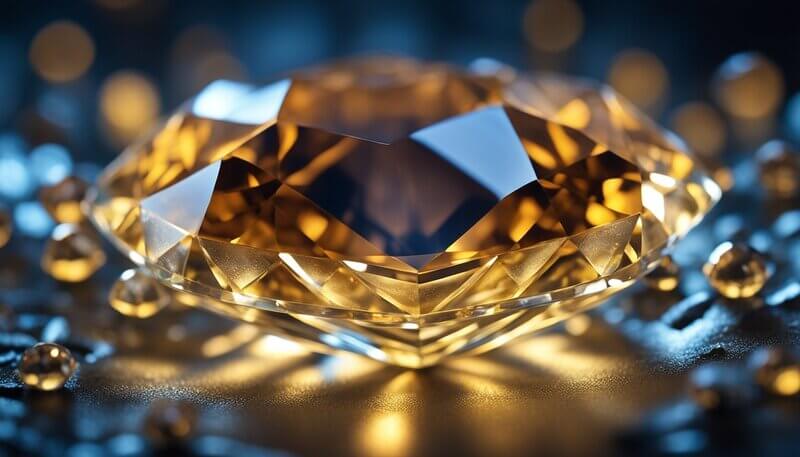
November birthstones, topaz and citrine, are admired for their beauty and rich history.
Their origins trace back to various global locations, each with unique geological characteristics.
Topaz Mining Regions
Brazil is renowned for its yellow and blue topaz, showcasing some of the most substantial deposits worldwide.
The country’s topaz mines are primarily situated in Minas Gerais, where these gemstones are extracted in significant quantities.
In addition to Brazil, Russia is also a notable source of topaz, particularly in the Ural Mountains, where mining activities unearth these valuable crystals.
- Brazil: Minas Gerais – Abundant in yellow and blue topaz
- Russia: Ural Mountains – Known historically for fine topaz gems
Citrine Deposits
Citrine, with its captivating yellow-to-orange hues, is predominantly found in Brazil, the largest gemstone supplier.
Rio Grande do Sul is particularly famous for its citrine reserves. Beyond Brazil, other deposits are scattered across the globe, although less prolific.
- Brazil: Rio Grande do Sul – High concentration of quality citrine
- Other Locations: Sparse occurrences; noted but less significant in volume
Each region brings its unique contributions to the market, encompassing a range of colors and qualities that cater to a diverse audience of gemstone enthusiasts and collectors.
Cultural and Symbolic Meanings
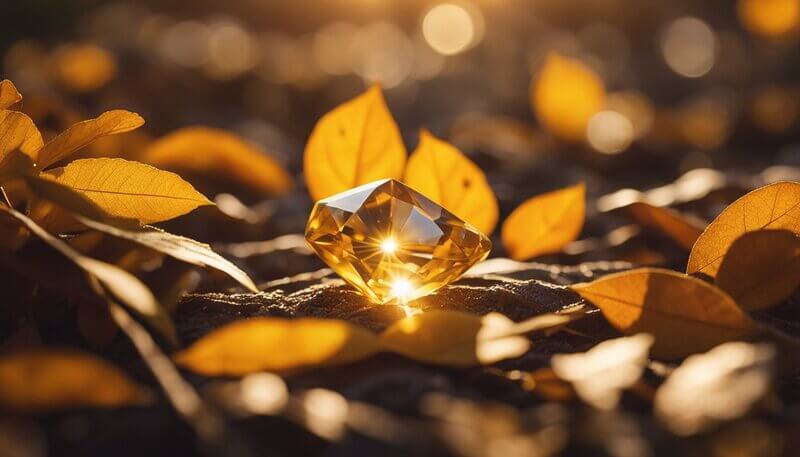
November birthstones carry a wealth of cultural and symbolic meanings stemming from both ancient traditions and modern interpretations.
They resonate with themes of prosperity, warmth, and celebratory milestones such as birthdays and wedding anniversaries.
Month and Zodiac Significance
November’s traditional birthstones—citrine and topaz—hold significant positions within cultural and zodiac frameworks.
For example, topaz is often associated with the zodiac sign Scorpio, a symbol of strength and tenacity.
It is believed that wearing topaz can bring about a sense of calmness and balance, essential for the transformative Scorpio season, which overlaps with November.
Citrine, a stone that ranges from pale yellow to brownish orange, is linked to the vibrancy of the remaining autumn season and mirrors the natural palette of the month.
Its hues and clarity are thought to encapsulate November’s aura of introspection and transition, enhancing personal clarity and the warmth of its wearer.
Anniversary and Gift-Giving
Regarding gift-giving, citrine and topaz are considered perfect gifts for the 13th and 17th years of marriage.
These stones signify lasting love and commitment, mirroring the traditional and modern beliefs of endurance and affection in marital unions.
Regarding prosperity and joy, November birthstones are also chosen as birthday gifts.
As symbolic of hope and wealth, these gems make sentimental and meaningful presents for individuals born this month.
The gifting of these stones is more than a celebration of another year; it is a wish for continued prosperity and good fortune for the recipient.
Market Insights and Trends
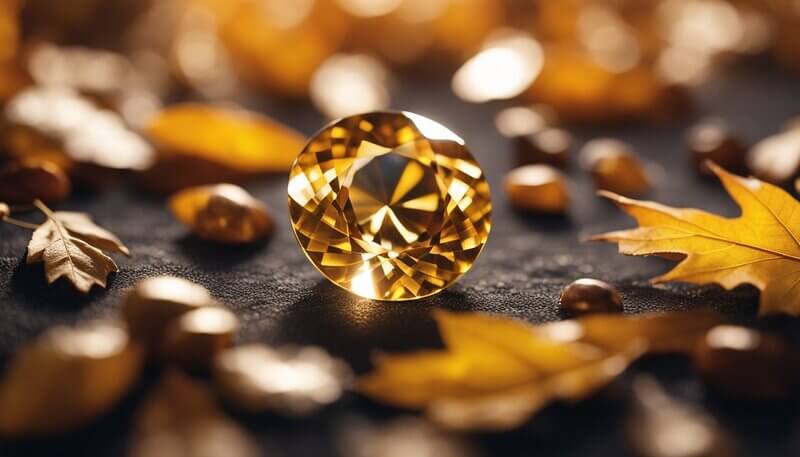
Within the gemstone market, November birthstones exhibit distinct positions.
Consumers consistently prefer the warmth and spectrum of hues offered by topaz and citrine, while investors analyze their growth in value and rarity as key factors in evaluating potential investments.
Consumer Demand
Customers are especially drawn to citrine’s charming yellow and orange hues, finding its appearance and affordability appealing.
Topaz, conversely, offers a breadth of color that caters to diverse tastes, including the prized blue and Imperial varieties.
Demand balances Topaz’s extensive color range and citrine’s accessible price point.
Investment Potential
Topaz and citrine illustrate divergent paths in investment potential.
Imperial topaz’s rare, deeply-colored shades indicate a notable investment allure reflected in market trends.
While more affordable, Citrine is considered a steady, low-risk addition to a gemstone portfolio.
Investors research these market dynamics to identify opportunities where the stones’ value could appreciate over time.
Frequently Asked Questions
In November, individuals celebrate their birth month with two unique gemstones known as topaz and citrine. These stones carry historical significance and distinctive colors that symbolize various qualities.
1. What are the two birthstones associated with November?
November is represented by two birthstones: citrine and topaz. Citrine is prized for its charming yellow to brownish-orange color palette, while topaz is celebrated for its wide range of colors, though it is often recognized for its yellow shades.
2. What is the significance of the November birthstone color?
The colors of November’s birthstones, ranging from yellow to rich orange, are often associated with warmth, happiness, and energy. These colors echo the hues of autumn and symbolize the sun’s soothing warmth during the month.
3. How do citrine and topaz differ from November birthstones?
Citrine and topaz differ in both composition and color spectrum. Citrine is a variety of quartz, generally found in yellow hues. In contrast, topaz is an aluminum silicate mineral with additional color variances due to impurities, including yellow, blue, pink, and more.
4. Can you wear a blue topaz if you were born in November?
Yes, individuals born in November can wear blue topaz despite its difference from the traditional yellow November birthstone color. Blue topaz is still a recognized variety of topaz and is one of the accepted gemstones for this month.
5. What jewelry options are popular for featuring November’s birthstones?
November’s birthstones are emphasized in diverse jewelry options, including rings, necklaces, bracelets, and earrings. Citrine is often set in gold to enhance its warm tones, while topaz can be found in various settings, reflecting its versatility.
6. Is there a symbolic meaning behind each of the November birthstones?
Each of the November birthstones carries symbolic meanings. Citrine is believed to represent vitality and health. Meanwhile, topaz is often associated with strength and wisdom.
Both stones are thought to help calm and heal, promoting a sense of tranquility.

